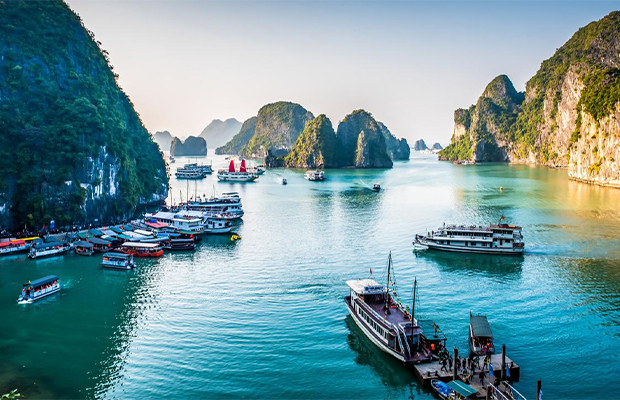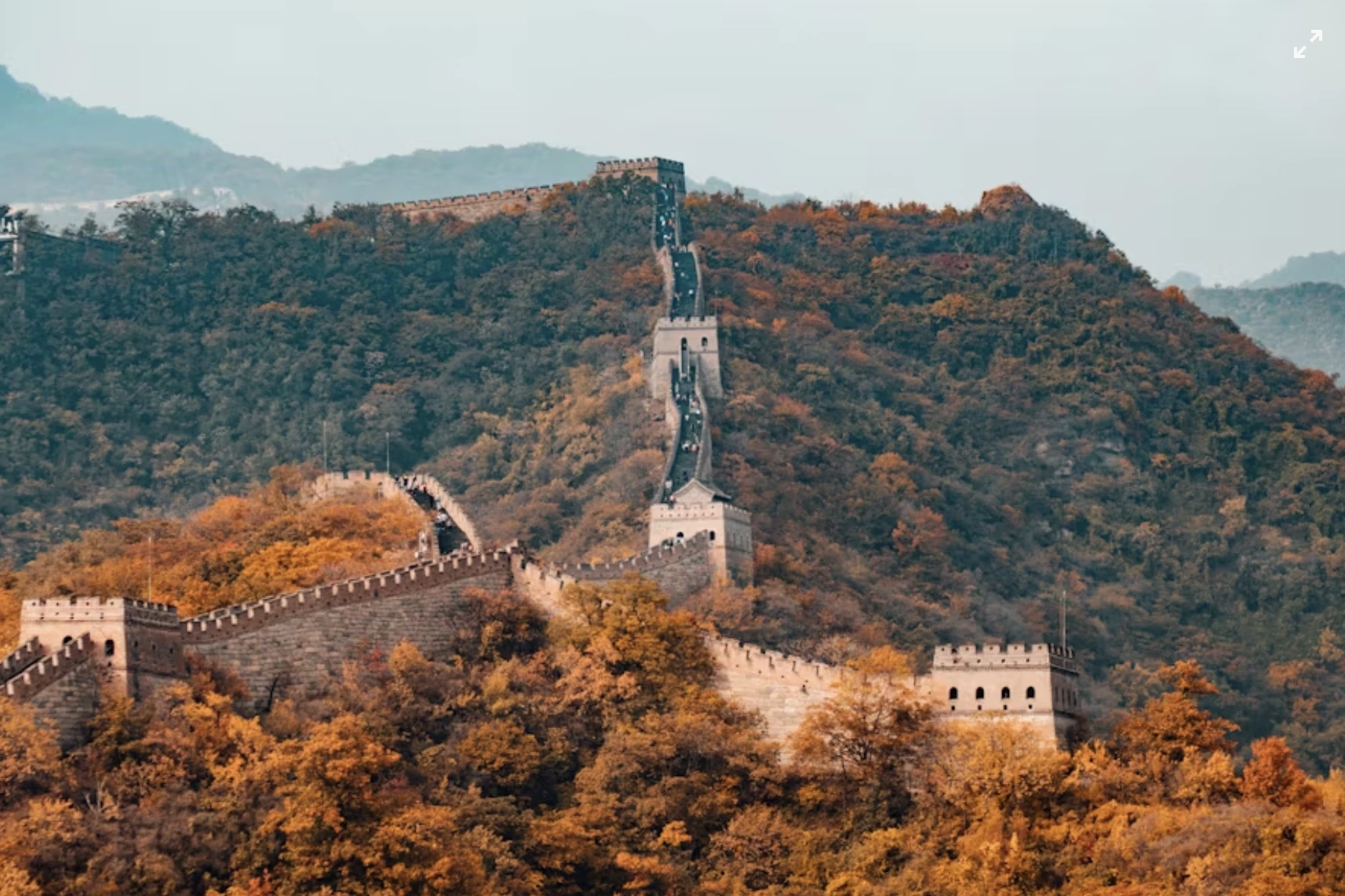(Latest Version) Travel Map of Laos and Vietnam & Planning Guide
Laos and Vietnam share not only a border but also centuries of history and culture. The two countries stretch north to south across mainland Southeast Asia, connected by mountains, rivers, and trade routes. Depending on your route, traveling between them can take just a few hours by air or a day by road.
Whether you are planning a slow overland journey or flying between major cities, a travel map of Laos and Vietnam is the first step toward a memorable trip. In this article, we’ll walk through the latest travel map of Laos and Vietnam, showing key routes, major cities, and scenic border crossings. It’s a simple guide to plan your route and make the most of your time.
![]() Where Are Laos and Vietnam on the Map?
Where Are Laos and Vietnam on the Map?
![]() What to See: Tourist Map of Laos and Vietnam
What to See: Tourist Map of Laos and Vietnam
![]() When to Go: Climate Map of Laos and Vietnam
When to Go: Climate Map of Laos and Vietnam
![]() How to Travel Around: Transport Map of Laos and Vietnam
How to Travel Around: Transport Map of Laos and Vietnam
![]() Suggested Tour Routes: Travel Map for Laos and Vietnam Tours
Suggested Tour Routes: Travel Map for Laos and Vietnam Tours
Where Are Laos and Vietnam on the Map?
On the map, Laos occupies a landlocked spot right in the center of Southeast Asia. Vietnam is located along the South China Sea with its characteristic S-shaped coastline. They share a border that stretches from the northern mountains down to the central highlands, running for approximately 2,130 kilometers.
That's one of the longest shared borders in Indochina region, which explains why crossing between the two countries is so common for travelers going from Vietnam to Laos. The border follows mountain ranges and river valleys most of the way. In the north, the terrain is steep and remote, while the central section offers easier crossings where roads connect towns on both sides.
The distance between major cities shows how well-connected Laos and Vietnam are. From Vientiane to Hanoi, it’s about 500 kilometers, a trip that usually takes 10 to 12 hours by road. Luang Prabang sits about 700 kilometers from Hanoi, so most travelers choose an overnight bus or short flight. In the south, Savannakhet is only 250 kilometers from Hue, making it one of the easiest crossings, with a travel time of around six hours by bus—ideal for smooth and scenic Vietnam Laos tours.

The Location Map of Vietnam and Laos.
What to See: Tourist Map of Laos and Vietnam
When you look at a tourist map of Laos and Vietnam, you’ll notice it revolves around three major experiences: culture, history, and nature. Both countries follow the same pattern of the Buddhist way of life which is depicted in the temples and the daily lives of the people. However, their beats are different.

The tourist map of Vietnam and Laos with main tourist cities.
Laos feels calm and timeless, while Vietnam mixes heritage with modern energy. Together, they offer a path filled with temples, rivers, coastlines, and beautiful towns. Travelers usually start their Laos tour in Luang Prabang.
Luang Prabang is a UNESCO World Heritage Site filled with golden temples and old colonial houses. Each morning, monks walk through the streets collecting alms – a local tradition worth seeing. Nearby Kuang Si Falls shines with turquoise water, and Mount Phousi gives a great view over the Mekong River.
Vientiane, the capital, moves at an easy pace and is best explored on foot or by bicycle. Its riverside cafés and landmarks like Pha That Luang and Patuxai Monument give it a gentle charm. North of the city, Vang Vieng has become a peaceful spot for kayaking, cave visits, and soaking in views of limestone cliffs and misty mountains.

Kuang Si Falls shines with turquoise water.
Across the border, northern Vietnam greets travelers with Hanoi’s lively charm, a perfect start to any Vietnam tour. The Old Quarter buzzes with food stalls, shops, and scooters weaving through narrow lanes. A few hours away, Halong Bay offers a calmer pace. Its limestone cliffs rise from emerald water, and an overnight Halong Bay cruise lets you take in the quiet beauty of the bay.
Moving south, Hue and Hoi An reveal Vietnam’s cultural soul. Hue holds the remains of ancient dynasties along the Perfume River, while Hoi An glows at night with its lanterns and riverside cafés. In the far south, Ho Chi Minh City brings energy and contrast – historic sites, modern towers, and day trips to the Cu Chi Tunnels or the Mekong Delta.

Hoi An has preserved many distinctive architectural features, such as the Japanese Bridge.
When to Go: Climate Map of Laos and Vietnam
Laos and Vietnam both have tropical climates. Still, weather varies a lot between the northern and southern parts of the countries. The map of Laos and Vietnam’s climate indicates the presence of two predominant seasons for both countries: dry and the wet. The dry season runs from November to April, when skies are clear, humidity drops, and temperatures are mild. It’s the best time to travel to Vietnam and Laos.
In Laos, daytime temperatures usually sit between 20°C and 28°C, while evenings can cool down to around 15°C, especially in the northern highlands. In northern Vietnam, winter months can feel quite cool, with Hanoi sometimes dipping below 15°C in January. This season is perfect for outdoor travel, sightseeing, and long road trips without the discomfort of heavy rain.
The wet season arrives from May to October, bringing higher humidity and vibrant green landscapes. In most regions, rain falls in short, heavy bursts rather than lasting all day. Southern Vietnam tends to be warmer and wetter, with average daytime temperatures around 30°C to 34°C.
For those looking to combine both countries, November to March is the ideal travel window. Roads are in better condition, and rivers like the Mekong are calm enough for cruises. Checking a climate map of Laos and Vietnam before planning a Vietnam and Laos tour helps match routes with the right weather.

The climate map of Vietnam and Laos.
How to Travel Around: Transport Map of Laos and Vietnam
Getting around Laos and Vietnam is easier than many expect. The transport map of Laos and Vietnam shows a clear network of roads, airports, and rivers. Major entry points include international airports in Vientiane, Luang Prabang, Hanoi, and Ho Chi Minh City. These cities connect directly through regional flights, making Southeast Asia multi-country travel in simple.
For those who prefer road travel, there are several active border crossings. The Nam Phao–Cau Treo and Lao Bao–Dansavanh checkpoints are among the most popular. Travelers heading from central Laos can reach Vietnam’s coast in a single day.
Buses and private transfers operate daily between the two nations. Train travel is more common inside Vietnam, while Laos relies mostly on roads. Air links from Hanoi to Laos are frequent, ideal for travelers short on time. Many visitors apply for a visa on arrival or e-visa before crossing the border.

The direct flights map between Vietnam and Laos.
Suggested Tour Routes: Travel Map for Laos and Vietnam Tours
Planning a trip that connects Vietnam and Laos is a wonderful way to see the best of both countries in one journey. A Vietnam and Laos itinerary gives travelers a mix of peaceful temples, lively cities, and beautiful natural views.
Whether you have one week or three, you can enjoy a nice balance of culture, food, and scenery. From the calm rivers of Luang Prabang to the busy streets of Hanoi and Ho Chi Minh City, each place has its own charm.

The tour routes map of Vietnam and Laos.
1-Week Route: Luang Prabang – Hanoi – Ho Chi Minh City
This one-week journey is ideal for travelers who want a quick but full view of both countries. It starts in Luang Prabang, where quiet temples and the Mekong River set a calm tone. A brief flight to Hanoi changes the pace completely. The city greets you with lively streets, food stalls, and peaceful spots around Hoan Kiem Lake.
From Hanoi, travelers usually end their trip in Ho Chi Minh City, the country’s largest and most dynamic hub. The contrast is clear the moment you arrive. This route blends calm, culture, and city buzz in just seven days.
2-Week Route: Luang Prabang – Vientiane – Hanoi – Halong Bay – Ho Chi Minh City
Two weeks allow a slower pace and more varied sights. The route begins in Luang Prabang before heading south to Vientiane, where French influence meets Buddhist architecture. The overland or short flight to Hanoi connects travelers directly to Vietnam’s cultural heart.
From Hanoi, a visit to Halong Bay adds a scenic escape. Cruising between limestone islands feels like a pause between cities. The final leg to Ho Chi Minh City rounds out the journey with modern attractions and historic landmarks.
3-Week Route: Laos Highlights + North to South Vietnam
Three weeks open space for a deeper experience. The trip starts in Laos, visiting Luang Prabang, Vientiane, and Vang Vieng. Travelers enjoy river valleys, limestone cliffs, and the relaxed pace that defines Laos. Crossing into northern Vietnam continues the rhythm, beginning with Hanoi and its mix of tradition and modern life.
From Hanoi, the path moves south through Hue and Hoi An before ending in Ho Chi Minh City.
Tips for Planning Vietnam and Laos Trips
Crossing between Laos and Vietnam isn’t complicated, but it’s worth planning before you go. You’ll need a valid passport and, in most cases, separate visas for each country. Some travelers don’t need Vietnam visas or Laos visas for short visits, while others can easily get an e-visa online.
Getting around both countries is pretty straightforward. Buses are cheap and connect most border towns. But if you’re short on time, flying is a lot faster from Laos to Vietnam. Vietnam has a good train system and the ride between Hanoi and Hue is one of the most scenic in Asia. Laos mostly relies on highways and vans, though the new Vientiane-Boten railway has made travel up north a lot smoother.
Respect goes a long way here. Dress modestly at temples, take off your shoes before entering, and greet monks politely. Locals appreciate small gestures, even a smile or a short hello in their language. And for the food, that’s an adventure in itself. From pho and banh mi in Vietnam to laap and sticky rice in Laos, every meal feels fresh, flavorful, and tied to local life.

Vietnam food is also a major draw for tourists visiting the country..
Conclusion
Laos and Vietnam sit next to each other on the map, but they offer different experiences. One is quiet and mountainous, the other is coastal and fast-moving. Together, they make for one of the best travel combinations in Southeast Asia. With Indochina Tour, exploring Laos and Vietnam becomes simple and personal. We map your route, book local stays, and include cultural stops worth seeing.
Whether you want quiet days in nature or busy nights in city streets, we are here to help you find the right balance. Contact us today to start planning your Laos-Vietnam getaway.
More Related Vitenam and Laos Travel Planning Articles
Most Popular Vitenam and Laos Tour Packages
-

 7 Days Glimpse of Vietnam and Laos Tour
7 Days Glimpse of Vietnam and Laos TourHanoi – Halong Bay – Luang Prabang
Start your 1-week journey from the profound city of Vietnam, Hanoi. Hop on a cruise in Halong Bay with multiple water sports ...
-

 10 Days Vietnam and Laos Highlights Tour Package
10 Days Vietnam and Laos Highlights Tour PackageSaigon – Hoi An – Hanoi – Halong Bay Cruise – Luang Prabang
Go on a 10-day trip with different experiences, from exploring cities to seeing amazing nature, making it an unforgettable ...
-

 9 Days Southern Vietnam and Laos Relaxing Tour
9 Days Southern Vietnam and Laos Relaxing TourLuang Prabang – Saigon – My Tho – Can Tho – Phu Quoc
Spend 3 days in Laos, having the unusual city walk in Luang Prabang with multiple natural destinations such as Pak Ou Caves ...
-

 23 Days In-depth Exploration Vietnam and Laos Tour
23 Days In-depth Exploration Vietnam and Laos TourVientiane – Vang Vieng – Luang Prabang – Pakse – Saigon – Nha Trang – Hoi An – Da Nang – Hue – Hanoi – Sapa – Halong Bay - Hanoi
More than 3 weeks of neraries for everyone this time… it leads you to slowly experience the two countries across South ...
Ask Us A Question For Free

.gif)
































.jpg)

